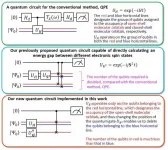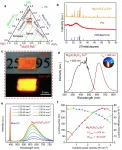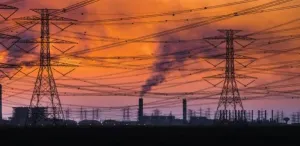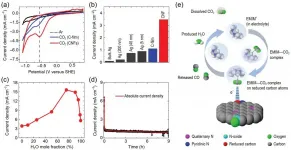(Press-News.org) A world-first 'flow model' devised by Australian researchers could drastically slash public transport commuter times during peak periods on some of the busiest roads in major cities, new research shows.
When this flow model was implemented to improve the worst traffic bottlenecks across Melbourne, commuters saved close to 2000 hours of travel time during a single morning peak period (7am-9am) and approximately 11,000 hours of passenger travel time during a normal weekday.
Ameliorating major traffic bottlenecks also contributed to a more than 23 per cent improvement in reliability of Melbourne's public transport network, on average, during weekdays and by up to 26 per cent on weekends.
Most bottlenecks were those that cut through the Melbourne central business district, yet links connecting suburban sites such as La Trobe and Monash universities, and Chadstone shopping centre to the metro train network were among the most critical bottlenecks in Melbourne's transport network.
Research by Monash University and RMIT University, published in the prestigious international journal Nature Communications, introduced a novel flow model - built upon the so called Unaffected Demand (UD) concept - to examine the impact of road congestion on travelling passengers using the bus and tram networks.
A flow network is the mathematical model for any system with a network structure where connections are a means for carrying some kind of flow from one component to another.
Traffic and public transport systems can be perfectly modeled as complex networks where different entities (intersections or stops) are mapped to a set of components (or network nodes), and the means for transportation of flow demand between these locations are represented as connections between the nodes.
"Whether it be passengers in transport systems, or energy in power grids, the primary purpose of most critical infrastructures is to carry some kind of flow between different locations," Professor Hai Vu, research co-author and Director of Monash University's Institute of Transport Studies, said.
"The introduced concept of UD is our simple yet effective way of measuring this flow, as well as its significance, to determine the reliability of demand-serving networks and identifying the impact of congestion at any particular part of the network in the 'big picture'.
"From our analysis we've identified the impact of mitigating congestion by any measure on a road segment - not only for passengers normally passing through that corridor, but also for all trips between different places that can potentially benefit from that decongested road as a new pathway."
Research co-author and student in Monash University's Faculty of Engineering, Homayoun Hamedmoghadam, said the most effective solution to avoid bottlenecks is to allocate segregated lanes and give priority to public transport vehicles in those high impact locations.
"On the one hand, dedicating road spaces to bus and tram vehicles will significantly improve functionality of the public transport network and its quality of service which encourages its use, and on the other hand, this means less road space, which is very well known to be a discouraging factor for car use," Mr Hamedmoghadam said.
The research team extracted the mobility demand of major cities from detailed transportation data and found that applying state-of-the-art theories from network science and physics can provide a different, yet more accurate, understanding of reliability and vulnerabilities of transport networks.
The real-world case studies in the paper tackles the problem of conflicting road congestion with passenger movements by on-road (bus and tram) public transport (PT) in both Melbourne and Brisbane.
Melbourne's on-road public transport network was, at the time of collecting data in 2017, comprised of approximately 5500 nodes, 10,500 links, and a flow demand derived from part of 470,000 trips performed during a normal weekday.
Brisbane had a relatively smaller network with approximately 1400 nodes and 3400 links on average on a regular weekday.
Associate Professor Mahdi Jalili from RMIT's School of Engineering said the proposed model is capable of identifying vital bottlenecks of the network even if they are located at any corridor other than the major roads.
"The application of our framework to any urban road network leads to determination of roads where congestion, regardless of its extent, has a detrimental effect on the quality of travel over the network as a whole. Of course, major roads are pathways for more traffic and they are more prone to congestion compared to back streets," Associate Professor Jalili said.
With the ever increasing availability of data and unprecedented advancements in scientific understanding of transportation systems, Professor Lewi Stone from RMIT's School of Science says there is much to benefit from cutting-edge research in policy making, planning, and management in the area of transportation.
"By exploiting this information, our analysis becomes capable of revealing the vital bottlenecks of transport networks which evolve during a day but follow a pattern that repeats day to day," he said.
"This means that we can identify adjustments required to fine-tune the network according to how passengers move throughout the day. We can also pinpoint problems in the network that hinder passenger movements at a certain time every day, like congestion bottlenecks of morning rush-hour."
INFORMATION:
This study was a collaboration involving Homayoun Hamedmoghadam and Professor Hai Vu (Institute of Transport Studies, Monash University), and Associate Professor Mahdi Jalili and Professor Lewi Stone (RMIT University).
To download a copy of the research paper, please visit https://rdcu.be/cfGMr or https://www.nature.com/articles/s41467-021-21483-y
MEDIA ENQUIRIES
Leigh Dawson
T: +61 455 368 260 E: media@monash.edu
OSAKA, Japan. Quantum computers have seen a lot attention recently as they are expected to solve certain problems that are outside the capabilities of normal computers. Primary to these problems is determining the electronic states of atoms and molecules so they can be used more effectively in a variety of industries - from lithium-ion battery designs to in silico technologies in drug development. A common way scientists have approached this problem is by calculating the total energies of the individual states of a molecule or atom and then determine the difference in energy between these states. In nature, many molecules grow in size and complexity, and the cost to calculate this constant flux is beyond the capability of any traditional ...
High-power laser diode (LD) driven solid-state lighting can generate super-high luminance far exceeding the state-of-art light-emitting diodes (LEDs) source by factors of 2-10, enabling it particularly attractive for automotive headlamp, outdoor lighting, multimedia projectors, laser TVs and so on. Whereas, the thermal shock of laser is extreme, and under intense laser excitation, traditional LEDs phosphor would suffer from luminescence degradation or even failure due to the luminescence saturation. Aiming to overcome this deficiency, highly efficient and stable luminescence bulk phosphors including single crystal, polycrystalline ceramic phosphor and glass ceramic composite phosphor ...
Solar-induced chlorophyll fluorescence (SIF) is emitted during plant photosynthesis. SIF results from vegetation chlorophyll giving off red and infrared light wavelengths when excited by solar radiation. Measuring SIF is important because it is closely related to the terrestrial gross primary productivity (GPP), which calculates the total amount of carbon dioxide fixed through photosynthesis in a given area. According to many laboratory and field experiments, studies show that SIF can effectively improve estimations of GPP, which is necessary for global carbon sink research and carbon mitigation strategies.
China has committed to carbon neutrality by 2060. Technological upgrades and energy structure adjustments through the next four decades will be vital to reducing carbon ...
This is a landmark study in so far as being the first to raise the alarm that, despite early successes with Covid-19 vaccines, further research is warranted on a next generation of Covid-19 vaccines.
The results from this study, however, only indicate that the AstraZeneca vaccine does not have at least 60% efficacy against mild-moderate Covid-19 due to the B.1.351 (N501Y.V2) variant.
Based on a broader body of evidence, the World Health Organization recommends that this vaccine still be deployed in countries where the B.1.351 variant circulates, as it likely still protects against severe ...
Researchers from Skoltech and their colleagues from Hadassah Medical Center have developed hybrid nanostructured particles that can be magnetically guided to the tumor, tracked by their fluorescence and pushed to release the drug on demand by ultrasound. This technology can help make cancer chemotherapy more targeted. The paper was published in the journal Colloids and Surfaces B: Biointerfaces.Current treatments for cancer include chemotherapy, immunotherapy, radiation, and surgery, but these are often not selective enough to target just the tumor ...
The diesel engine is the backbone of transportation due to its irreplaceability as the primary power source for the freight, navigation and marine engine industries and non-road engineering machinery for the foreseeable future. However, the control of contaminants from fuel combustion has become an urgent global concern. Nitrogen oxides are the primary pollutants from transportation and can contribute to the formation of haze, photochemical smog and acid rain. Selective catalytic reduction of NOx with ammonia (NH3-SCR) technology has been successfully and commercially applied for controlling pollution from diesel vehicle exhaust. The development of ...
Electronic organic materials offer promise to support alternative and green energy sources to meet escalating global energy demands and strict environmental regulations. A KAUST-led team has now developed electron-transporting, so-called n-type, organic semiconductors that could help generate electricity from waste heat released by industrial processes and homes.
Thermoelectric generators that can convert temperature changes or gradients into electricity are highly suited for harnessing waste heat. These readily scalable devices are environmentally friendly and do not have any moving parts, which makes them ...
The use of fossil fuels as energy carriers and raw materials promotes the rapid development of the society. However, the excessive exploitation of fossil fuels gives rise to the energy crisis and undesirable environmental changes. In particular, a continuous increase of CO2 concentration in the atmosphere, which is > 400 ppm today and is estimated to triple by 2040, might result in a series of environmental issues, such as global warming, rising sea levels, and more extreme weather. Therefore, cutting CO2 emissions and developing abundant renewable energy are urgent needs and challenges for our society.
CO2 is not only one of the main greenhouse gases but also an abundant, nontoxic, nonflammable, and renewable C1 resource. Electrochemical conversion of CO2 is an attractive way to recycle ...
According to a new study published in the Journal of the Royal Society of Medicine, the carbon footprint of personal protective equipment (PPE) provided to health and social care staff in England during the first six months of the COVID-19 pandemic was equivalent to flying from London to New York 244 times every day. The good news is that adopting a range of strategies including increased UK manufacture, reusing and recycling could reduce the environmental impact of PPE dramatically while maintaining the safety of staff and patients.
The study, by Brighton and Sussex Medical School and Brighton and Sussex University Hospitals NHS Trust, found that the 3 billion items of PPE used from ...
Precision or invar alloys have been developed by scientists for many centuries. These iron and nickel-based alloys are capable of keeping their size unchanged within a given range of temperatures. Because of this, they are used in the manufacture of precision gages, standards of length, details for mechanical dial plates, and similar devices. However, invar alloys lack many other useful physical characteristics, and this limits their use in other areas, for example, those that require high thermal conductivity of materials. Therefore, scientists have long been trying to create a unique composite material based on other metals ...






